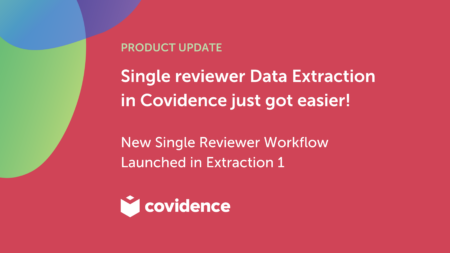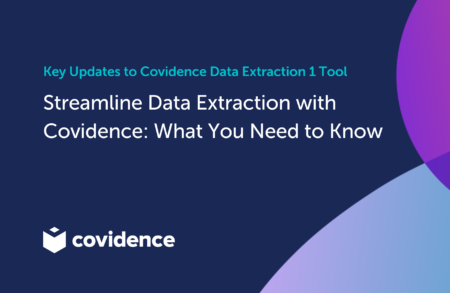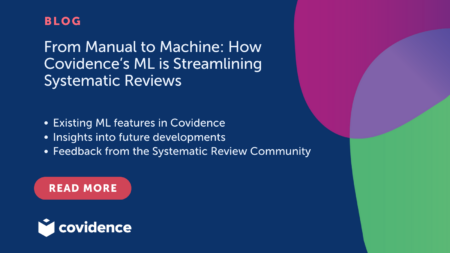Introducing a new data extraction and quality assessment template in Extraction 1
Overview
We’re excited to announce a new Extraction 1 template! The new template allows for easy creation, piloting, and updating of data extraction and quality assessment templates. Updates made to the data extraction and quality assessment template will be applied to all studies to ensure consistent data collection across studies.
The template has been designed specifically for intervention reviews, however other types of reviews can benefit from many of the fields and sections.
Other features of the new template include:
- Structured sections for intervention reviews
- Easily customise each section by adding additional fields
- Easy access to knowledge base articles with best practice and advice on what data to collect
- All updates made to the template will be promoted to all studies in data extraction, supporting consistent data collection.
- See who last published the template and when.
- There won’t be any surprises when you export, as the template is the source of truth. You can export to RevMan Web, RevMan5, CSV, and Excel.
For reviews that haven’t started extraction you’ll be able to use the new template in Extraction 1! Alternatively you can take a look by using the demo review found on “Your reviews” page.
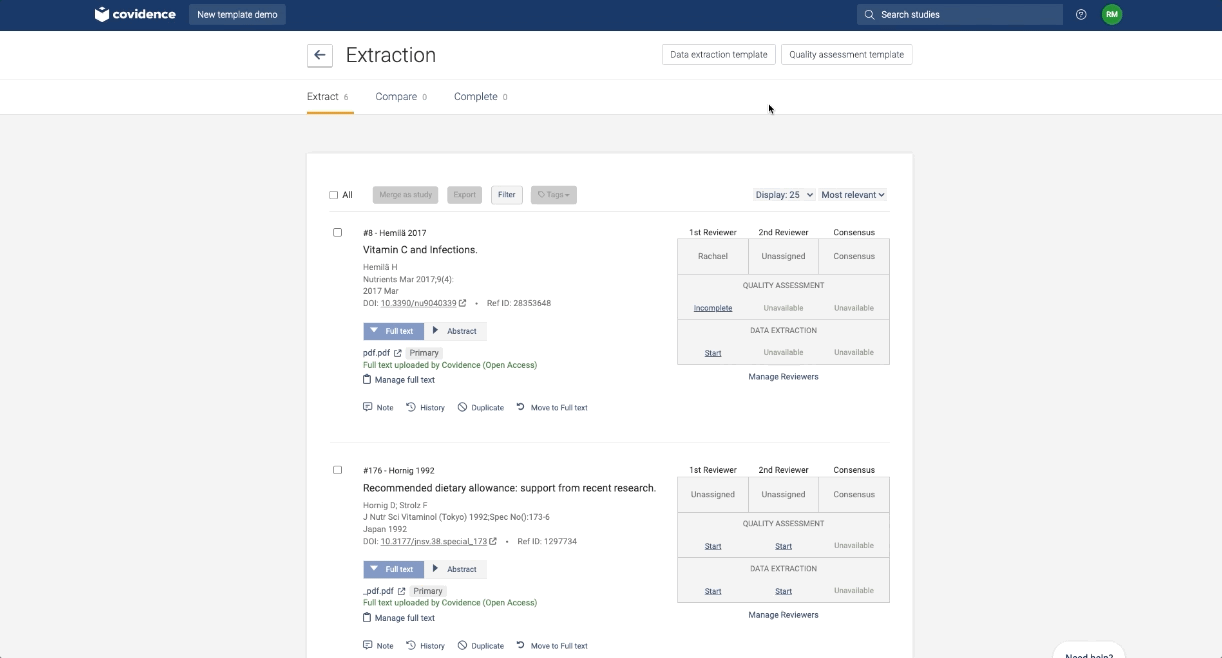
Covidence has two versions of data extraction: Extraction 1 and Extraction 2 (learn more here).
Creating a data extraction template
To use the data extraction template, simply navigate to the Extraction tab on the Review Summary screen and click the “Create data extraction template” button to get started.

The template has 5 sections designed for an intervention review:
- Identification
- Methods
- Population
- Interventions
- Outcomes
You can customise the template to fit your specific review needs, and once you’re happy with the fields you’ve added, save the changes by clicking the “Publish template” button. Publishing the template will make the template available to all authors of the review and all changes will be applied to all studies.
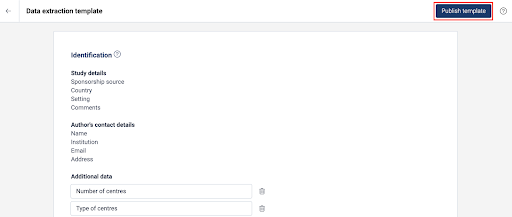
Next time you open the template, you’ll be able to see who last published the template and when.

Updating a data extraction template
When you update the template, all changes will be promoted to all studies in Extraction 1. This is so consistent data can be collected against all studies.
If you have started data extraction for any study and you delete a field, then you’ll see a warning. This is to ensure that you don’t accidentally delete data that has been extracted.
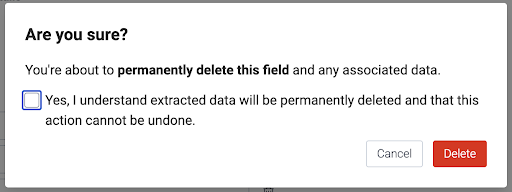
When you make a change to the data extraction template and hit publish, you’ll be able to select whether or not you wish to revisit studies you have completed.
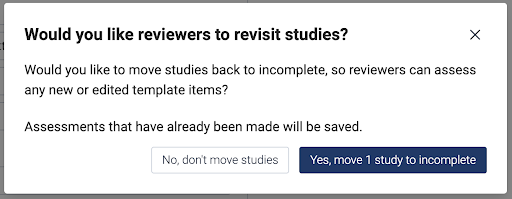
Other reviewers will see a notification when they next go to the extraction page to let them know the template has been updated and/or studies have been moved to incomplete.


Creating a quality assessment template
To use the quality assessment template, simply navigate to the Extraction tab on the Review Summary screen and click the Create quality assessment template button to get started.

You will have the option of using the Cochrane ROB1 template or you can create a custom template.

Choosing the Cochrane RoB template populates domains in line with Cochrane’s original Risk of Bias tool for randomised controlled trials, which can be edited as required.
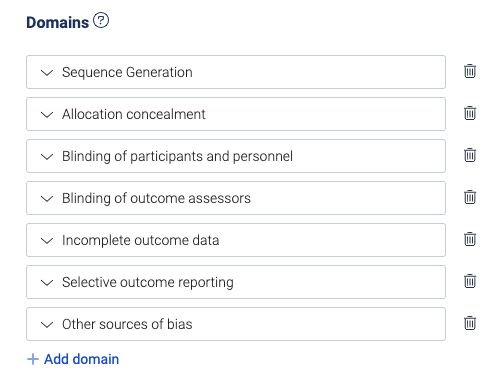
On the quality assessment template, you can define outcome groups.
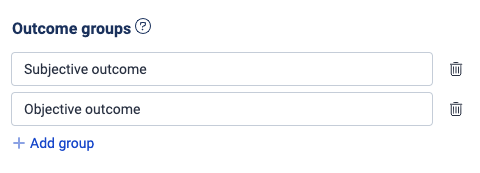
When extracting data for a study you can categorise outcomes that are reported into outcome groups and you can choose to assess the quality of each outcome group independently instead of for the study as a whole.
This might be useful if you’re expecting outcome groups to differ in their risks of bias for example subjective outcomes vs objective outcomes.
Once you are happy with the domains and outcome groups defined within the template, save the changes by clicking the Publish template button at the top of the screen. This will make the template available to all authors of the review.

Next time you open the template, you’ll be able to see who last published the template and when.

Updating a quality assessment template
Just like the data extraction template, when you update the quality assessment template, all changes will be promoted to all studies in Extraction 1. This is so consistent assessments can be made against all studies.
If you have started data extraction for any study and you delete a domain or an outcome group, then you’ll see a warning. This is to ensure that you don’t accidentally delete data that has been collected.
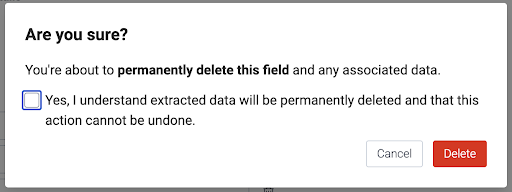
When you publish an update to the template, this won’t impact the status of a study. For example if a study is in the status of “Done” it will remain as “Done” after you hit publish.
When you make a change to the quality assessment template and hit publish, you’ll be able to select whether or not you wish to revisit studies you have completed.
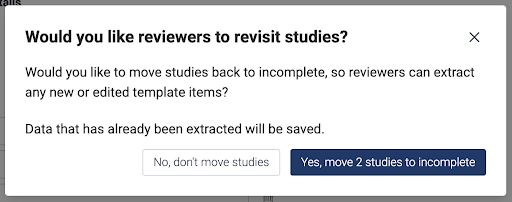
Just like with the data extraction template, other reviewers will see a notification when they next go to the extraction page to let them know the template has been updated and/or studies have been moved to incomplete.


Are you interested in an institutional license for your entire organization? Follow this link to request a consultation or recommend your institution, here.
Why is obtaining an institutional license for Covidence more beneficial for the entire organization compared to individual subscriptions?
An institutional license to Covidence can benefit the entire organization by providing a centralized platform for systematic reviews that can improve research quality, streamline the review process, and enhance collaboration among researchers. It can also save costs by providing a more affordable option for multiple users, as well as offering administrative benefits such as easier management of licenses and user access. Learn more about an institutional license here.

